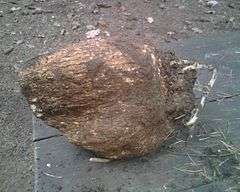Wolfiporia extensa
| Wolfiporia extensa | |
|---|---|
 | |
| Wolfiporia extensa sclerotium | |
| Scientific classification | |
| Kingdom: | Fungi |
| Division: | Basidiomycota |
| Class: | Agaricomycetes |
| Order: | Polyporales |
| Family: | Polyporaceae |
| Genus: | Wolfiporia |
| Species: | W. extensa |
| Binomial name | |
| Wolfiporia extensa (Peck) Ginns (1984) | |
| Synonyms[1] | |
Wolfiporia extensa (Peck) Ginns (syn. Poria cocos F.A.Wolf) is a fungus in the family Polyporaceae. It is a wood-decay fungus but has a subterranean growth habit. It is notable in the development of a large, long-lasting underground sclerotium that resembles a small coconut. This sclerotium called "(Chinese) Tuckahoe" or fu-ling, is not the same as the true tuckahoe used as Indian bread by Native Americans, which is the arrow arum, Peltandra virginica, a flowering tuberous plant in the arum family. W. extensa is also used extensively as a medicinal mushroom in Chinese medicine.[2] Indications for use in the traditional Chinese medicine include promoting urination, to invigorate the spleen function (i.e., digestive function), and to calm the mind.[3]
Common names include hoelen, poria, tuckahoe, China root, fu ling (茯苓, pīnyīn: fúlíng), and matsuhodo.
Botanical extract
Wolfiporia extensa is a source of a triterpenoid compound, pachymic acid, which has been the object of scientific study based upon the mushroom's role in traditional Chinese medicine. The species is often called cocos in this context.[4]
References
- ↑ "GSD Species Synonymy: Wolfiporia extensa (Peck) Ginns". Species Fungorum. CAB International. Retrieved 2015-08-09.
- ↑ Esteban CI. (2009). "Interés medicinal de Poria cocos (= Wolfiporia extensa)" [Medicinal interest of Poria cocos (= Wolfiporia extensa)]. Revista Iberoamericana De Micología (in Spanish). 26 (2): 103–7. doi:10.1016/S1130-1406(09)70019-1. PMID 19631158.
- ↑ Bensky D, Clavey S, Stoger E. (2004) Eastland Press, Inc. Seattle, 3rd ed. ISBN 0939616424. p. 267
- ↑ Cheng S, Swanson K, Eliaz I, McClintick JN, Sandusky GE, Sliva D (2015). "Pachymic acid inhibits growth and induces apoptosis of pancreatic cancer in vitro and in vivo by targeting ER stress". PLoS ONE. 10 (4): e0122270. doi:10.1371/journal.pone.0122270. PMC 4411097
 . PMID 25915041.
. PMID 25915041. 
External links
- Wolfiporia extensa in Index Fungorum
- Hoelen (Poria)
- Medicinal Mushrooms: Their Therapeutic Properties and Current Medical Usage with Special Emphasis on Cancer Treatments by Cancer Research UK, 2001